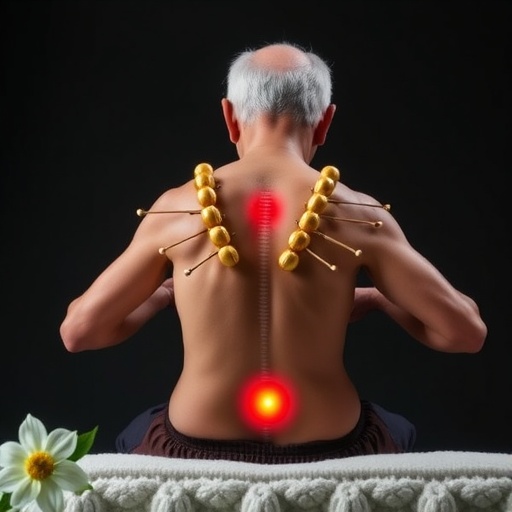A groundbreaking clinical trial published in JAMA Network Open has shed new light on the effectiveness of acupuncture needling in managing chronic low back pain among older adults. This randomized study, involving a robust cohort of elderly participants, provides compelling evidence that acupuncture not only relieves pain but also significantly improves functional disability related to chronic back conditions compared to standard medical care alone. The enduring benefits observed at both six and twelve months mark a pivotal moment in alternative pain management strategies for aging populations.
Chronic low back pain remains one of the most prevalent and disabling conditions impacting the elderly worldwide. Conventional medical treatments often fall short in providing long-term relief without the risk of adverse effects, leading many to explore complementary medicine modalities. Acupuncture, an ancient technique rooted in traditional Chinese medicine, has gained increasing acceptance but lacked sufficient high-quality randomized clinical trial evidence in older adults — a gap this study effectively addresses.
The randomized clinical trial design ensured rigorous control and minimized bias, enrolling older adults diagnosed with persistent low back pain that had not responded adequately to usual care. Participants were assigned either to receive a standardized course of acupuncture needling or to continue with conventional treatments, including pharmacologic pain management and physical therapy. The primary outcome focused on improvements in disability scores specifically related to back pain, assessed through validated measurement scales at two critical follow-up points: six and twelve months post-intervention.
Data analysis revealed that subjects undergoing acupuncture exhibited statistically and clinically meaningful reductions in back pain disability, surpassing the improvements seen in those receiving usual medical care alone. Importantly, these positive effects persisted at one year, suggesting acupuncture’s therapeutic benefits extend well beyond the immediate treatment window. The researchers underscored the safety profile of acupuncture, citing no serious adverse events, which bolsters its appeal as a non-pharmacologic alternative for elderly populations frequently burdened by multiple comorbidities and medication sensitivities.
Underlying these outcomes is acupuncture’s hypothesized mechanism of action involving neuromodulation and endogenous opioid release. Needle stimulation at specific acupoints purportedly triggers biochemical cascades that attenuate nociceptive signaling pathways and modulate inflammatory mediators contributing to chronic pain. While the precise neurophysiological intricacies remain an active area of research, this study’s clinical data substantiate acupuncture’s capacity to effect sustained functional improvements in chronic pain syndromes.
This research addresses a critical healthcare challenge – the management of chronic pain in aging adults – by demonstrating that acupuncture needling can be integrated effectively into standard clinical practice. The findings advocate for broader adoption of acupuncture within multidisciplinary pain management frameworks, potentially reducing reliance on opioids and their associated risks, including dependency and systemic side effects, especially pertinent amid the ongoing opioid crisis.
The study also highlights the importance of personalized and patient-centered approaches in treating chronic low back pain. By comparing acupuncture directly with usual care rather than combining treatments, the trial uniquely clarifies acupuncture’s standalone efficacy, offering clinicians evidence-based guidance when considering therapeutic options tailored to older adults who may have contraindications to pharmacotherapy.
Furthermore, the research methodology incorporated rigorous randomization to ensure balance between study groups, enhancing the validity of findings. Statistical analyses employed were appropriate for longitudinal clinical data, including adjustment for potential confounders, ensuring that observed outcome differences were attributable to the intervention itself. Such methodological robustness elevates the credibility of the conclusions drawn and reinforces the value of acupuncture as a scientifically supported treatment modality.
This study’s implications extend beyond clinical practice to influence health policy and insurance coverage decisions. As healthcare systems grapple with the escalating costs of chronic disease management, evidence supporting safe, effective, and low-cost interventions like acupuncture could drive changes in reimbursement policies, making these therapies more accessible to aging populations who stand to benefit most.
Notably, the trial focused specifically on older adults, an often underrepresented group in clinical research, responding to the call for inclusivity in studies that inform geriatric care. This demographic specificity empowers healthcare providers with targeted evidence, fostering informed decision-making grounded in the unique physiological considerations and therapeutic needs of elderly patients suffering from chronic musculoskeletal pain.
While the results are promising, the authors caution that acupuncture should be viewed as part of a comprehensive pain management strategy rather than a universal cure. Ongoing research is encouraged to explore optimal treatment dosing, frequency, and combination with other modalities to maximize patient outcomes. Additionally, mechanistic studies may elucidate biomarkers predictive of response, enabling precision medicine approaches within integrative pain therapies.
In conclusion, this randomized clinical trial significantly advances the understanding of acupuncture’s role in treating chronic low back pain among older adults by demonstrating sustained improvement in disability over one year. Its favorable safety profile and efficacy position acupuncture as a viable, evidence-based adjunct or alternative to conventional medical care. As the medical community continues to seek multifaceted approaches to managing chronic pain, these findings serve as a pivotal endorsement of integrating traditional therapies into modern clinical paradigms to enhance quality of life in aging populations.
Subject of Research: Effectiveness of acupuncture needling in reducing back pain–related disability in older adults with chronic low back pain.
Article Title: [Not provided]
News Publication Date: [Not provided]
Web References: [Not provided]
References: (doi:10.1001/jamanetworkopen.2025.31348)
Image Credits: [Not provided]
Keywords: Acupuncture, Back pain, Older adults, Chronic pain, Clinical trials, Randomization, Medical treatments, Health care, Traditional Chinese medicine




